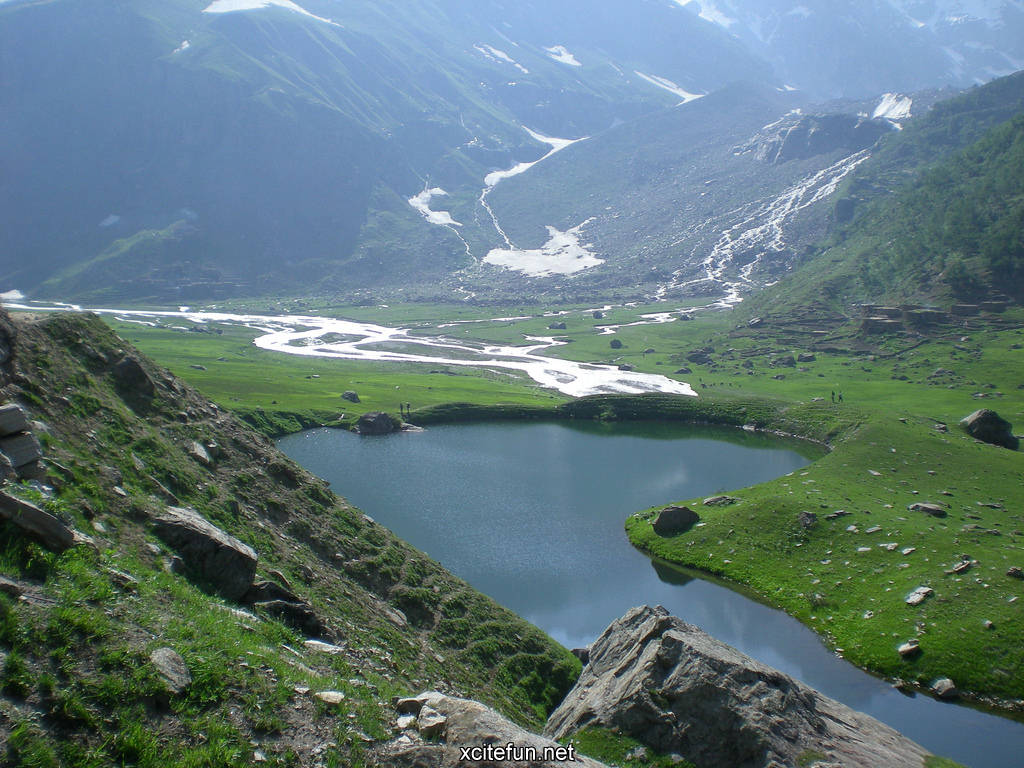State Flag
State FlagThe official flag the State of Azad Jammu & Kashmir was adopted on 24th September 1975. The flag was adopted by the passing of the Azad Jammu and Kashmir State Flag Ordinance, 1975 by the then president, Sardar Mohammad Ibrahim Khan.
Symbolically the Flag represents following aspects of Azad Jammu and Kashmir;
 |
The Three Fourth green background represents 75% Muslim population of the State of Jammu and Kashmir. |
 |
 |
One-Fourth Orange (Golden) colour represents 25% minorities of the State of Jammu and Kashmir. |
|
 |
The Green stripes represent the Valley of the State of Jammu and Kashmir. |
|
 |
The White stripes represent the snow-covered mountains of the State of Jammu and Kashmir. |
|
 |
The Crescent is the usual semblance of the State of Jammu and Kashmir. |
Azad Jammu & Kashmir is a fascinating land of people, languages & culture. The texture of present population is composed of races claiming their descent from Semitic, Mongoloid, Aryans, Persians, Turks & Arabs. The people of districts Kotli, Mirpur & Bhimber are sturdy, simple, truthful and deeply attached to their land. The culture of this area resembles to that of the adjoining area of Punjab. The people of districts Poonch, Bagh & Sudhanoti are adventure loving and there are numerous anecdotes of their matchless valor as well as inspiring sacrifices for freedom, while Muzaffarabad & Neelum district has its own distinctive culture. The people of the state are intelligent ingenious, hardworking & dynamic.







 The
majority of the rural population depends on forestry, livestock and
agriculture for its subsistence. Average per capita income is estimated
to range from 600 -5,000 US$. Un-employment rate is from 35 to 50%. In
line with the national trends, indicators of social sector improvement,
particularly health and population welfare have not shown much
proficiency. Efforts have been made during the recent past to make up
this deficiency, which will bring the fruits of development to the
common man. The area under cultivation is around 166,432 hectares
(almost 13% of the total area), out of which 92% of the cultivable area
is rain-fed.
The
majority of the rural population depends on forestry, livestock and
agriculture for its subsistence. Average per capita income is estimated
to range from 600 -5,000 US$. Un-employment rate is from 35 to 50%. In
line with the national trends, indicators of social sector improvement,
particularly health and population welfare have not shown much
proficiency. Efforts have been made during the recent past to make up
this deficiency, which will bring the fruits of development to the
common man. The area under cultivation is around 166,432 hectares
(almost 13% of the total area), out of which 92% of the cultivable area
is rain-fed.  About
845 households have very small land-holdings between one to two acres
per family. According to the agricultural census of 1990, the average
farm size is only 1.2 hectares. The major crops are Maize, Wheat &
Rice whereas minor crops include vegetables, grams, pulses (Red lobia)
and oil-seeds. Major fruits are Apple, Pears, Apricot and Walnuts.
Income through household earnings ranges between 30-40% while remaining
share comes from other sources including employment and business etc.
Reduced agriculture productivity has adversely affected the traditional
lifestyle and average per capita income of the rural household. About
42% of the total Geographical area (0.6 million hectares approximately)
is controlled by the Forest Department. The per capita standing volume
and area are 400 cft and 0.2 hectares respectively. Annual wood demand
is 1.65 million cubic meters and sustainable production is 0.7 million
cubic meters.
About
845 households have very small land-holdings between one to two acres
per family. According to the agricultural census of 1990, the average
farm size is only 1.2 hectares. The major crops are Maize, Wheat &
Rice whereas minor crops include vegetables, grams, pulses (Red lobia)
and oil-seeds. Major fruits are Apple, Pears, Apricot and Walnuts.
Income through household earnings ranges between 30-40% while remaining
share comes from other sources including employment and business etc.
Reduced agriculture productivity has adversely affected the traditional
lifestyle and average per capita income of the rural household. About
42% of the total Geographical area (0.6 million hectares approximately)
is controlled by the Forest Department. The per capita standing volume
and area are 400 cft and 0.2 hectares respectively. Annual wood demand
is 1.65 million cubic meters and sustainable production is 0.7 million
cubic meters.






